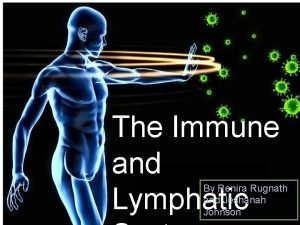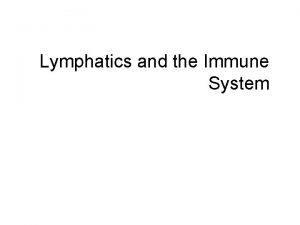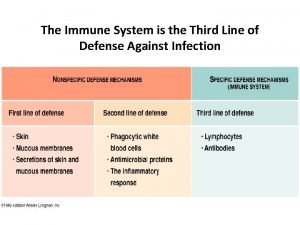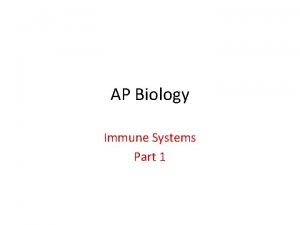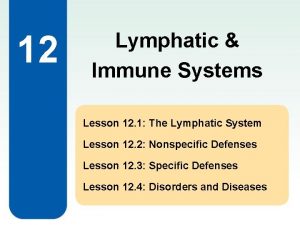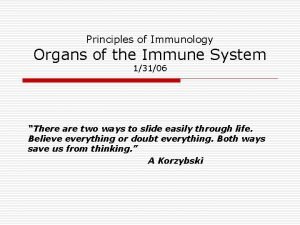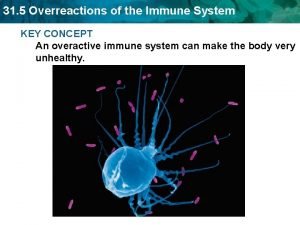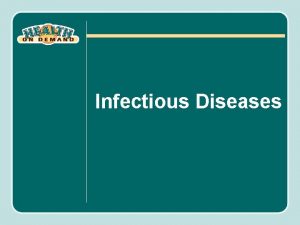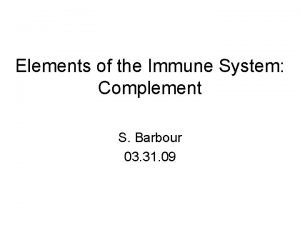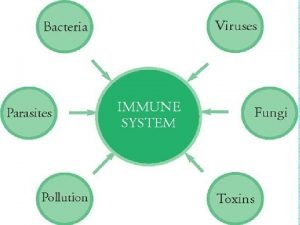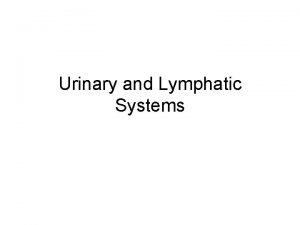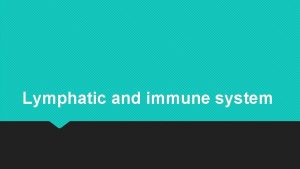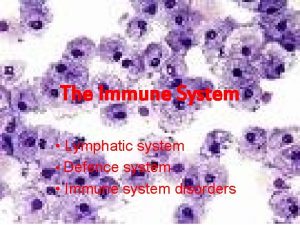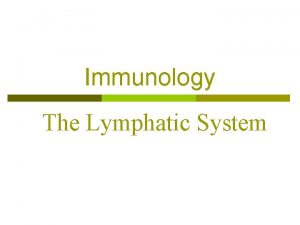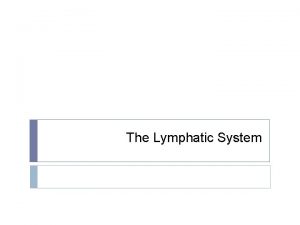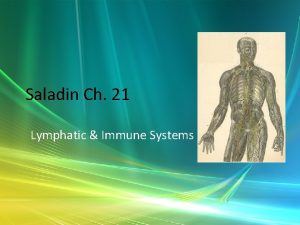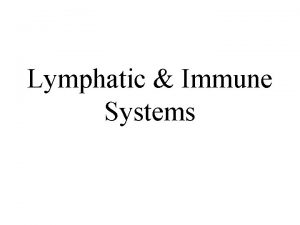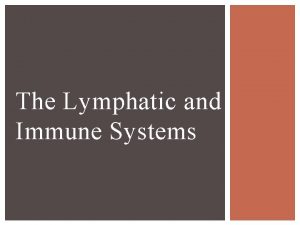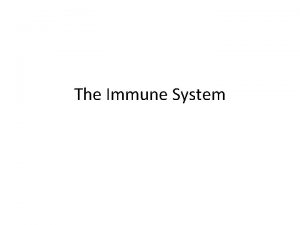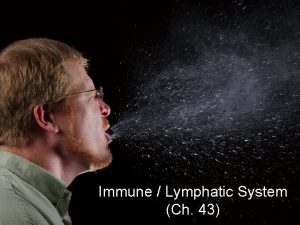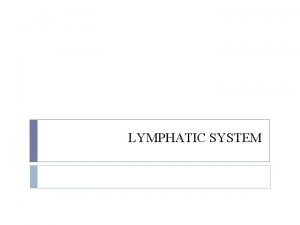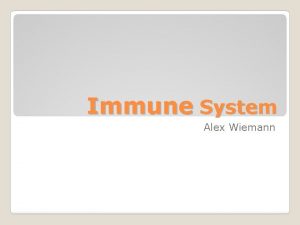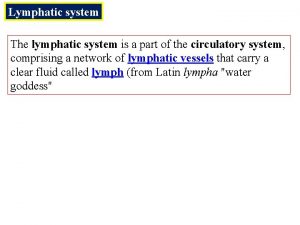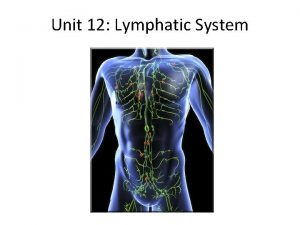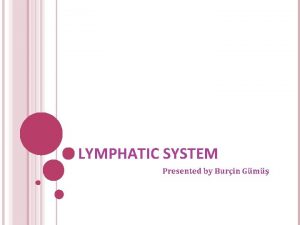The Immune System Lymphatic system Defence system Immune





























- Slides: 29

The Immune System • Lymphatic system • Defence system • Immune system disorders

• Inside your body there is an amazing protection mechanism called the immune system. It is designed to defend you against millions of bacteria, microbes, viruses, toxins and parasites (pathogens) that would love to invade your body

THE LYMPHATIC SYSTEM • A network of vessels and nodes throughout the body • Lymph is a pale, yellow interstitial fluid (similar to blood plasma)

• Lymph serves to maintain fluid balance in the body • Lymph nodes contain lymphocytes and macrophages (phagocytic monocytes) which serve to trap & destroy bacteria

LYMPH NODES

• Viral and bacterial infections are by far the most common causes of illness for most people. They cause things like colds, influenza, measles, mumps, malaria, AIDS and so on. The job of your immune system is to protect your body from these infections. The immune system protects you in three different ways:

1. It creates a barrier that prevents bacteria and viruses from entering your body. (eg – skin) 2. If a bacteria or virus does get into the body, the immune system tries to detect and eliminate it before it can make itself at home and reproduce. (eg – phagocytic white blood cells) 3. If the virus or bacteria is able to reproduce and start causing problems, your immune system is in charge of eliminating it. (eg – B and T cells)

The Immune System is the Third Line of Defense Against Infection

Nonspecific Defenses (FIRST LINE - Physical Barriers) Figure 22. 10

Nonspecific Defenses (SECOND LINE - Phagocytes) Figure 22. 10

Nonspecific Defenses (SECOND LINE - Immunological Surveillance) Natural killer T cells (cytotoxic T cells) destroy body cells that have become cancerous or infected by viruses Figure 22. 10

Nonspecific Defenses (SECOND LINE – Complement System) Figure 22. 10

Specific Defences (Antibody-Mediated Immunity) • Antibodies are proteins that recognize foreign substances (antigens) and try to neutralize or destroy them. • Antibodies are produced by LYMPHOCYTES

• All white blood cells are known officially as Leukocytes. • White blood cells are not like normal cells in the body - they actually act like independent, living single-cell organisms able to move and capture things on their own.

• White blood cells behave very much like amoeba in their movements and are able to engulf other cells and bacteria.

• Many white blood cells cannot divide and reproduce on their own, but instead have a factory somewhere in the body that produces them. That factory is the bone marrow.

• Antibodies are produced by white blood cells. • They are Y-shaped proteins that each respond to a specific antigen (bacteria, virus or toxin). • Each antibody has a special section (at the tips of the two branches of the Y) that is sensitive to a specific antigen and binds to it in some way.

• When an antibody binds to the outer coat of a virus particle or the cell wall of a bacterium it can stop their movement through cell walls. Or a large number of antibodies can bind to an invader and signal to the complement system that the invader needs to be removed.

The immune system response • Antigen triggers an immune response • Activates T cells and B cells – T cells are activated after phagocytes exposed to antigen • T cells attack the antigen and stimulate B cells • Activated B cells mature and produce antibody • Antibody attacks antigen

An Overview of the Immune Response Figure 22. 15

Major types of T cells • Cytotoxic (Killer) T cells – attack foreign cells – pucture a hole in cell membrane • Helper T cells – activate other T cells and B cells • Suppressor T cells – inhibit the activation of T and B cells – make sure normal tissue isn’t destroyed • Memory T cells – remain in bloodstream and can act quickly if antigen comes into blood again

Types of Immunity Figure 22. 14

IMMUNE SYSTEM DISORDERS ALLERGIES • An allergy is an exaggerated response of the immune system to a harmless material (eg – pollen, pet dander, grass, peanuts, etc)

ALLERGIES 2 types of allergic reactions: • Immediate (or acute) - occurs within seconds of exposure – disappears within 30 minutes (eg) pets, nuts, pollen • Delayed - reaction is slower and lasts longer - T-cells are sensitized by previous contact (eg) cosmetics, jewellery

What happens during an immediate allergic reaction? • Specialized antibodies trigger certain cells to release histamines • Histamines are chemicals that increase the permeability of blood vessels • Therefore, blood (mostly plasma with some WBCs) leaks out of the vessels and into the tissues – causing them to become red and swollen • Symptoms: itchy, puffy eyes, runny nose, constriction of airways (asthma, or anaphylaxis)

What is anaphylaxis? • Anaphylaxis is a severe allergic reaction to a specific allergen – eg peanuts, bee stings, etc. • Airways can close almost immediately – which can be fatal • An injection of adrenaline (Epi-pen) is given

COMMON ALLERGENS

AUTOIMMUNE DISORDERS • Your body identifies your own cells as “self” cells • Sometimes, T cells or antibodies make mistakes and attack your own cells, mistaking them for “non-self” cells • An autoimmune disorder is the result • EXAMPLES: rheumatoid arthritis, Type I diabetes

RHEUMATOID ARTHRITIS • A chronic autoimmune disorder • Characterized by inflammation of the joints • Most common in people 25 -50 years • Immune system attacks bone, cartilage, ligaments
 Lymphatic vs immune system
Lymphatic vs immune system Phagocitize
Phagocitize Phagocytic cells
Phagocytic cells A subsequent
A subsequent Chapter 24 the immune and lymphatic systems and cancer
Chapter 24 the immune and lymphatic systems and cancer What empties into the left subclavian vein
What empties into the left subclavian vein Lympathic
Lympathic Lymphatic system organs and functions
Lymphatic system organs and functions What is the third line of defense in the immune system
What is the third line of defense in the immune system Hangman flowchart
Hangman flowchart Third line of defense immune system
Third line of defense immune system Innate immunity first line of defense
Innate immunity first line of defense Chapter 35 immune system and disease
Chapter 35 immune system and disease Primary vs secondary immune response
Primary vs secondary immune response Ap bio immune system
Ap bio immune system Lesson 12.1 lymphatic ducts and vessels
Lesson 12.1 lymphatic ducts and vessels Lesson 12 blood and immune system
Lesson 12 blood and immune system Immune system lymph nodes
Immune system lymph nodes Immunity definition
Immunity definition Overreactions of the immune system
Overreactions of the immune system Defination of tuberculosis
Defination of tuberculosis The main function of immune system
The main function of immune system Histology of lymphoid tissue
Histology of lymphoid tissue Thymus
Thymus Immune complex
Immune complex Thalassemia autosomal recessive
Thalassemia autosomal recessive 1what's the purpose of the body's immune system?
1what's the purpose of the body's immune system? Lymph nodes lower body
Lymph nodes lower body What are the function of lymphatic system
What are the function of lymphatic system Chapter 12 the lymphatic system and body defenses
Chapter 12 the lymphatic system and body defenses
